Techview QV-3135 User Manual

4
With 4pcs 720P Camera Kit
3135

USER MANUAL |
|
Contents |
|
CHAPTER 1 FUNCTIONAL DESCRIPTIONS AND FEATURES........................... |
1 |
CHAPTER 2 OVERVIEW OF DVR.............................................................................. |
2 |
2.1 FRONT PANEL............................................................................................................... |
2 |
2.2 Rear Panel............................................................................................................. |
3 |
2.3 REMOTE CONTROLLER (FOR REFERENCE ONLY, GOODS IN KIND PREVAIL).................................. |
4 |
CHAPTER 3 DVR CONNECTION............................................................................... |
4 |
3.1 HDD INSTALLATION....................................................................................................... |
4 |
3.2 IP CAMERA AND MONITOR CONNECTION.......................................................................... |
4 |
3.3 POWER SUPPLY CONNECTION.......................................................................................... |
5 |
CHAPTER 4 DVR BOOT UP........................................................................................ |
5 |
4.1 SYSTEM INITIALIZATION................................................................................................... |
5 |
4.2 STARTUP WIZZARD........................................................................................................ |
5 |
4.3 MAIN INTERFACE........................................................................................................... |
6 |
CHAPTER 5 DVR MENU.............................................................................................. |
7 |
POPUP MENU.................................................................................................................... |
7 |
5.1 MAIN MENU GUIDE...................................................................................................... |
8 |
5.2 MAIN MENU................................................................................................................ |
9 |
5.2.1 PARAMETER............................................................................................................... |
9 |
5.2.2 Record Search.............................................................................................. |
17 |
5.2.3 Device............................................................................................................ |
21 |
5.2.4 PTZ and Cloud Storage.............................................................................. |
22 |
5.2.5 System........................................................................................................... |
23 |
5.2.6 Advanced....................................................................................................... |
26 |
5.2.7 Shutdown...................................................................................................... |
27 |
5.3 MENU LOCK............................................................................................................... |
27 |
5.4 SPLIT MODE.......................................................................................................... |
27 |
5.5 RECORD SEARCH................................................................................................. |
27 |
5.6 MUTE...................................................................................................................... |
28 |
5.7 START SEQUENCE................................................................................................. |
28 |
CHAPTER 6 WEB APPLICATION MANAGER....................................................... |
28 |
6.1 ACTIVEX CONTROL DOWNLOAD AND INSTALLATION............................................................ |
28 |
6.2 WEB APPLICATION MANAGER LOGIN............................................................................. |
29 |
6.3 LIVE INTERFACE........................................................................................................... |
30 |
6.3.1 Menu Bar...................................................................................................... |
30 |
6.3.2 Playback........................................................................................................ |
31 |
6.3.3 Remote Setting........................................................................................... |
34 |
6.3.4 Network.......................................................................................................... |
36 |
6.3.5 Alarm.............................................................................................................. |
39 |
6.3.6 Device............................................................................................................ |
40 |
2

|
USER MANUAL |
6.3.7 System........................................................................................................... |
41 |
6.3.8 Advanced....................................................................................................... |
43 |
6.3.9 Local Setting................................................................................................. |
46 |
6.3.10 Logout.......................................................................................................... |
46 |
CHAPTER 7 APPENDIX............................................................................................. |
47 |
7.1 TROUBLESHOOTING.............................................................................................. |
47 |
7.2 USAGE MAINTENANCE.......................................................................................... |
48 |
7.3 SYSTEM CONNECTION DIAGRAM.................................................................................... |
49 |
7.4 ACCESSORIES (GOODS IN KIND PREVAIL).......................................................................... |
49 |
3

USER MANUAL
SAFETY INSTRUCTION
Please carefully read the following safety instruction so as to avoid personal injuries and prevent the equipment and other connection devices from being damaged.
1.Power sources (note: please use the power supply attached or specified by the manufacturer)
Never operate the equipment by using unspecified power supply.
2.Never push objects of any kind through openings of DVR
Never push objects of any kind through openings of DVR so as to avoid electric shock or other accidents.
3.Do not put the equipment in the dusty field
Do not put the equipment in the dusty field.
4.Do not place the equipment under rain or humid environment
Do not place the equipment under humid environment like basement. If the equipment is accidentally in contact with water, please unplug the power cable and immediately contact your local dealer.
5. Keep the surface of the equipment clean and dry
Use soft damp cloth to clean the outer case of DVR (do not use liquid aerosol cleaners)
6. Do not operate if any problems are found
If there are any strange smell or sound from DVR, unplug the power cable and contact the authorized dealer or service center.
7. Do not try to remove the upper cover
Warning: Do not remove the cap of DVR so as to avoid electric shock.
8. Handle with care
If DVR does not work normally because of hitting on the hard object, please contact the authorized dealer for repair or replacement.
9.Use standard lithium battery (Note: Use the batteries attached or specified by the manufacturer)
After cutting off the power supply, if the system clock cannot continue to work, please replace the standard 3V lithium battery on the main board.
Warning: Turn off DVR before replacing the batteries, or you may be suffered from serious electric shock. Please properly dispose of the used batteries.
10.Put the equipment in a place with good ventilation
The DVR system includes HDD, which produces large amount of heat during operation. As a result, do not block the ventilation openings (on the top, bottom, both sides and the reverse side) for cooling the system during operation. Install or put the equipment in the place with good ventilation.
11.The attached power adapter can only be used for 1 set of DVR. Do not connect more equipment, or DVR may be restarted repeatedly because of insufficient power
12.Prevent the equipment from water dropping or splashing. Do not place objects containing water, such as flower vase, on the equipment
4
Chapter 1 Functional Descriptions and
Features
|
Function |
Brief Description |
|
Real time |
Support output by monitor, VGA and HDMI, support real-time monitoring by |
|
web application manager and mobile phone, and support electronic amplifier, |
|
|
monitoring |
|
|
multi-screen sequence and PIP display. |
|
|
|
|
|
|
Support video compression standard of H.264. The video quality, resolution of |
|
Recording |
each channel and video frame rate are adjustable. Support many recording |
|
modes, such as start-up recording, timing recording, manual recording, alarm |
|
|
|
|
|
|
recording, motion detection recording, remote recording, etc. |
|
Record |
Support high capacity HDD with SATA port. The records can be stored |
|
storage |
immediately in HDD. |
|
Record |
Support single-channel or multi-channel search and playback by DVR or |
|
playback |
network. |
|
Record |
Backup records from DVR to U flash disk, mobile HDD and disk burner; or from |
|
backup |
network to HDD. |
|
Alarm |
Support alarm management of HDD and video input and the signal input from |
|
setting |
external alarm apparatus. |
|
Network |
Support authorized accessing of remote client to ensure the system security. |
|
operation |
|
|
|
|
|
Mouse |
Support USB mouse operation to set system parameters conveniently and |
|
operation |
efficiently. |
|
|
Support PTZ decoder communicated through RS485. It can expand two kinds |
|
PTZ control |
of decoding protocol to realize PTZ and dome camera control. Support PTZ |
|
|
preset auto cruise function. |
|
|
Table 1-1 |
Features: |
|
|
●H.264 video compression format, support 960H display resolution;
●G.711 audio compression format;
●Windows style graphic user interface and embedded real-time Linux 2.6 operation system;
●Warm menu prompt;
●Full real-time six functions (preview, recording, playback, backup, network monitoring, and mobile phone monitoring);
●Support dual-stream network transmission;
●Support smart phone video monitoring;
●Support electronic amplifying and channel sequence display; ●Video packaging time is adjustable;
●multiple alarm modes;
●USB2.0 port, support backup, burning, software upgrading, mouse operation, etc;
●Support infra-red remote control;
●Support multi-language;
●Support automatic system maintenance;
1
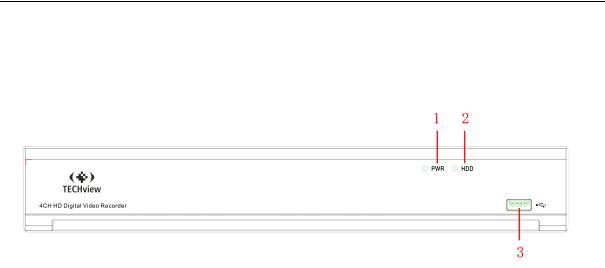
USER MANUAL
Chapter 2 Overview of DVR
2.1 Front Panel
SN |
Key or indicator |
Identification |
Functions |
|
|
|
|
|
|
1 |
Power indicator |
PWR |
If the “Green” indicator is on, DVR is getting power |
|
normally. |
||||
|
|
|
||
2 |
HDD indicator |
HDD |
If the “Red” indicator flashes, the hard drive is being |
|
read or written to. |
||||
|
|
|
||
|
|
|
|
|
3 |
USB |
|
USB port |
|
|
|
|||
|
|
|
|
2
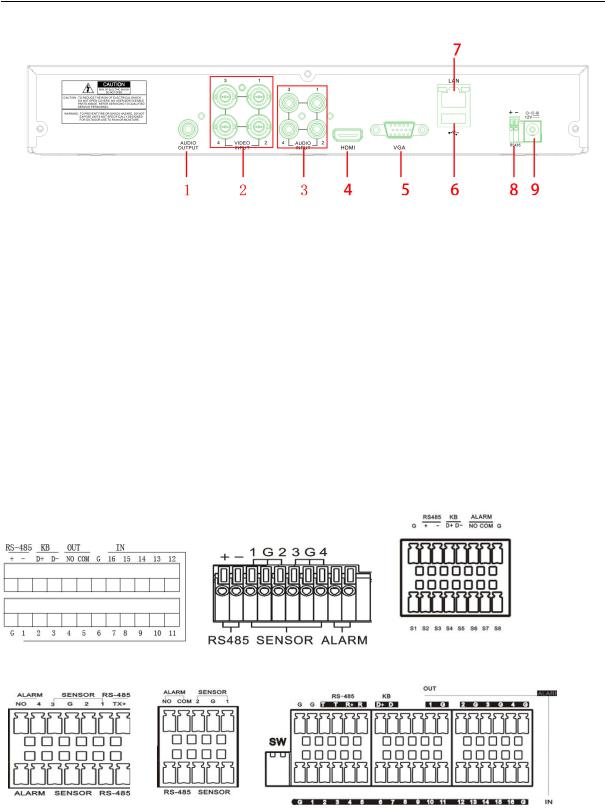
USER MANUAL
2.2 Rear Panel
SN |
Physical Interface |
Connection |
|
1 |
Audio output |
Audio signal output, RCA port |
|
2 |
Video input |
Connect with CH1-4 (analog) video input device, standard BNC port |
|
3 |
Audio input |
Connect with CH1-4 audio input signals, RCA port |
|
4 |
HDMI Port |
Connect to HDMI monitor |
|
5 |
VGA port |
Connect with VGA display devices, such as PC monitor |
|
6 |
USB port |
Connect with U flash disk, disk burner, and other USB storage devices |
|
7 |
LAN: Network port |
Connect with LAN, Ethernet and RJ45 port. |
|
8 |
RS-485/Sensor/Alarm |
RS485/Sensor/Alarm port. Connect by referring to the interface definition |
|
below |
|||
|
|
||
9 |
Power port |
Connect with the power supply DC12V 3A, attached with the machine |
The following diagrams shows the interface definition of sensor input / alarm output /RS485:
Alarm input: Check your purchased alarm device and connect a G (GND) foot to the port marked with “-” and connect the alarm channel to the port marked with “+”.
Alarm output: Two ports marked with OUT.
PTZ port: Check your purchased PTZ and connect to the two ports (+ -) marked with RS 485.
3
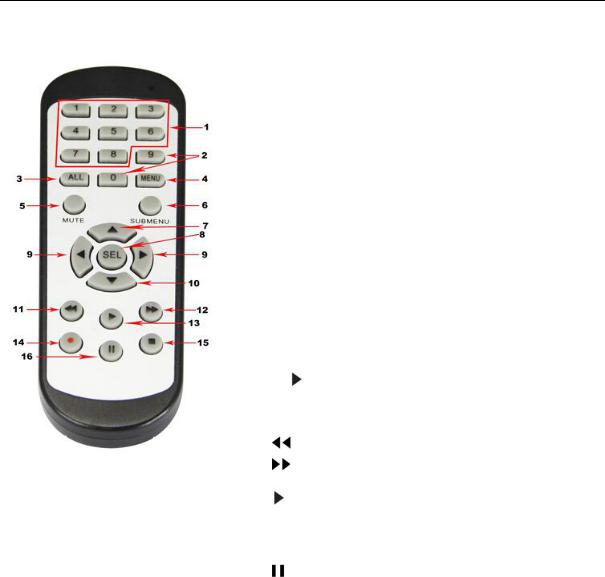
USER MANUAL
2.3 Remote Controller (For reference only, goods in kind prevail)
Ite |
Key title |
Key function |
m |
|
|
|
|
|
1 |
1-8 |
Channel select 1-8; Numeric key |
2 |
9 0 |
Numeric key; Clicking numeric “0” allow |
|
you switch to output device |
|
|
|
|
3 |
ALL |
Multiple display mode |
4 |
Menu |
Enter into Main menu/Exit |
5 |
Mute |
Mute on/off |
6 |
SUBMEN |
Go to submenu |
|
U |
|
7 |
▲ |
Up arrow key, Volume adjust |
8 |
SEL |
Select key/Edit key; |
|
Confirm the selected operation. |
|
|
|
|
9 |
|
Left/Right key, |
|
◄/ |
Decrease/increase parameter value of |
|
|
control bar |
10 |
▼ |
Down arrow key, Volume adjust |
11 |
|
Rewind key |
12 |
|
Forward key |
13 |
|
Enter into record search menu; |
|
|
Play key |
14 |
● |
Record key |
15 |
■ |
Stop manual record; stop playing |
16 |
|
Pause |
Chapter 3 DVR Connection
3.1 HDD Installation
Caution: Please do not take out hard drive when DVR is running! HDD Installation:
(1)Cut power firstly, and then remove screws on both sides and rear panel and open DVR upper cover.
(2)Connect HDD data line and power line to the main board. Install the HDD to fix it on the bracket and then connect the HDD power line and data line.
(3)Put the upper cover back carefully
Note: If user requires higher performance HDD, it is strongly recommended to use special hard drive for security and protection.
3.2 IP Camera and Monitor Connection
DVR video output signals are transmitted to VGA monitor or HDMI monitor by VGA or HDMI cable and DVR video can be monitored (Refer to section 1.2 Rear Panel). Refer to Chapter 6 System Connection Diagram.
4
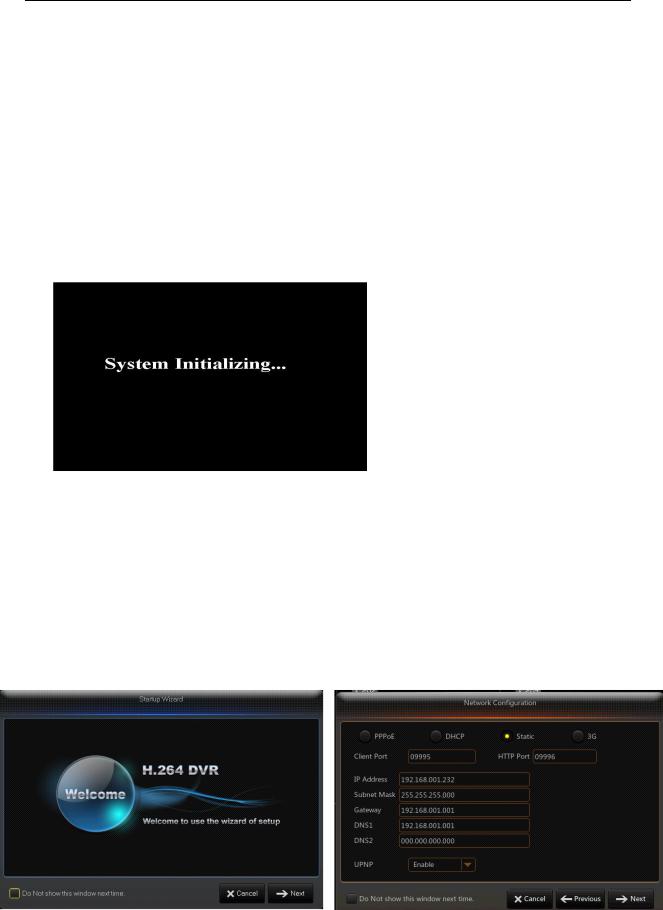
USER MANUAL
3.3 Power Supply Connection
Please use attached power adapter to connect DVR. Before power on, make sure the cables on the audio and video I/O ports and network port are well connected. For audio ports, please use microphone and other audio devices together with BNC connecting line to input or output audio signals.
Chapter 4 DVR Boot up
4.1 System Initialization
After connecting the power cable of DVR to wall outlet and pressing the power button, you will enter into the DVR system initializing screen shown as Picture 4-1.
Note The illustration in the user manual may not be the same as the menu interface in your monitor. All the illustrations are only for users’ reference.
Picture 4-1
4.2 Startup Wizzard
After DVR startup is completed, the startup wizard will be displayed. If you do not want to make any setting, you may click “Don't show this window next time” to cancel, as shown in Picture 4-2.
Wizard setting menu includes: Homepage, Network setup, Record Schedule and HDD.
1. Homepage and network setup. In network setup page, user may set the network environment of DVR, as shown in Picture 4-3
Picture 4-2 |
Picture 4-3 |
5

USER MANUAL
2. Record Schedule (Picture 4-4). It can set recording time and scheduled recording of DVR.
Picture 4-4
3. HDD Management (Picture 4-5). It supports HDD format and overwrite type.
Picture 4-5
4.3 Main Interface
Picture 4-6
Note: When internal HDD is not connected to DVR, the character “H” will appear on the lower part of the main interface and accompany buzzer alarm. If you want to disable the buzzer alarm, please enter into [EventAlarm] to disable HDD loss alarm, HDD space insufficiency alarm and set alarm output to “off”.
6
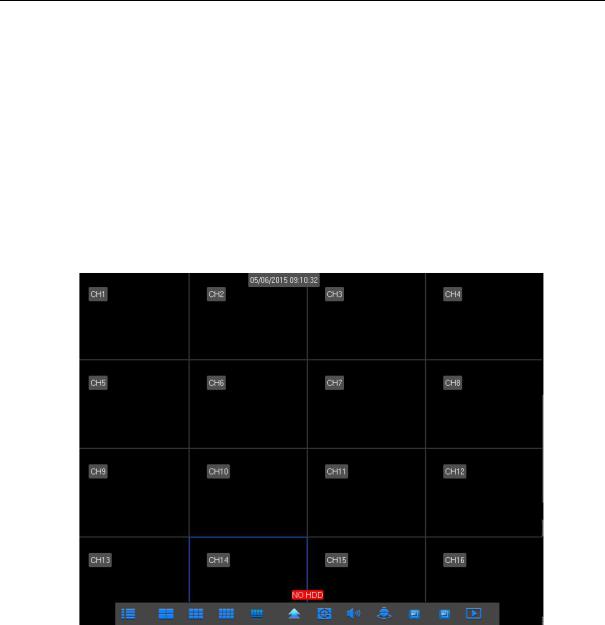
USER MANUAL
Chapter 5 DVR Menu
Popup Menu
After finishing system initialization, click right key of mouse on preview interface or slide the mouse to the bottom of screen to enter into Pop-up Menu. Now you could perform parameter setting and operate on Main Menu, Multi-screen, Auto Cruise, Record Search, Sequence, Volume setting and Brightness setting, shown as Picture 5-1.
The options in the pop-up menu may be varied slightly according to different parameter settings and application environment. The options in the menu will be explained in detail in the following chapters.
Picture 5-1
7
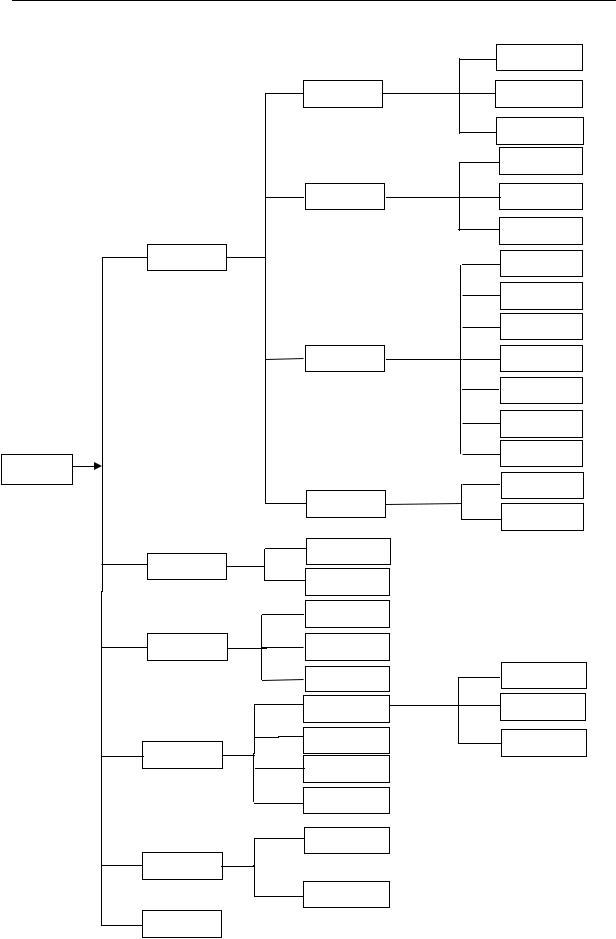
USER MANUAL
5.1 Main Menu Guide
Parameter
Main Menu
Record
Device
System
Advanced
Shutdown
Display
Record
Network
Alarm
Record
Event Search
HDD
PTZ
Cloud Storage
General
Users
Info
Log
Maintenance
Events
Live
Output
Private Zone
Record
Schedule
Mainstream
Network
Substream
DDNS
RTSP
FTP
Motion
Alarm
General
DST
NTP
8
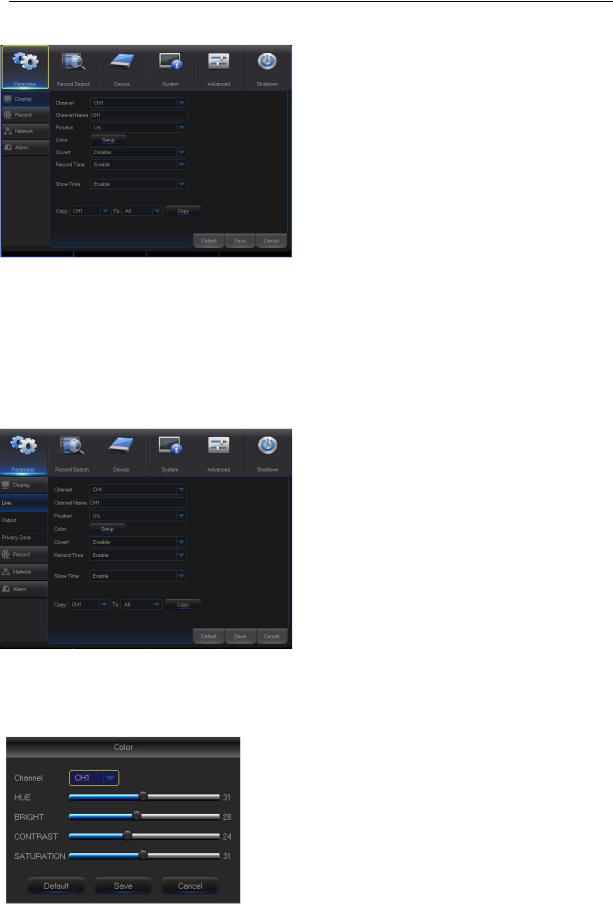
USER MANUAL
5.2 Main Menu
On LIVE mode, click the mouse button, or [Menu] button on the remote controller, or
click [  ] icon on the toolbar to enter the
] icon on the toolbar to enter the
main menu screen, as shown in Picture 5-2. If system interface is locked, refer to section 4.3 to unlock by inputting password. In Main Menu mode, you can make settings for Parameter, Record Search,
Device, System, Advanced and Shutdown.
Picture 5-2
5.2.1 Parameter
1. Live
Go to “Main Menu” → “Parameter” → “Display” → “Live” to enter into the interface shown as Picture 5-3.
Picture 5-3
Picture 5-4
Channel: Select the channel in the drop-down list.
Channel Name: Channel name, support up to 8 characters or 4 Chinese characters.
Position: Set the position for the channel display
Color: Click “Setup” to enter into the color setting page (Picture 5-4)
Image hiding: Enable or disable the channel real-time monitoring
Show Time: Enable or disable the system time display in the live interface.
Copy: Copy the parameters in the channel to any other channel or all channels.
Record Time: Enable or disable displaying system time in recording.
Copy: Copy the setting parameter of a channel to another channel.
Adjust the brightness, hue, contrast and saturation of the image in selected channel in “Live” interface.
Note To modify the parameter value in sub-menu and make it effective, click “Save” after modification and a dialog box with message “parameters have been successfully saved” will pop up. Click “OK” in the interface and click “Exit” to exit the menu. If you want to cancel the modification, click “Cancel” to exit.
9
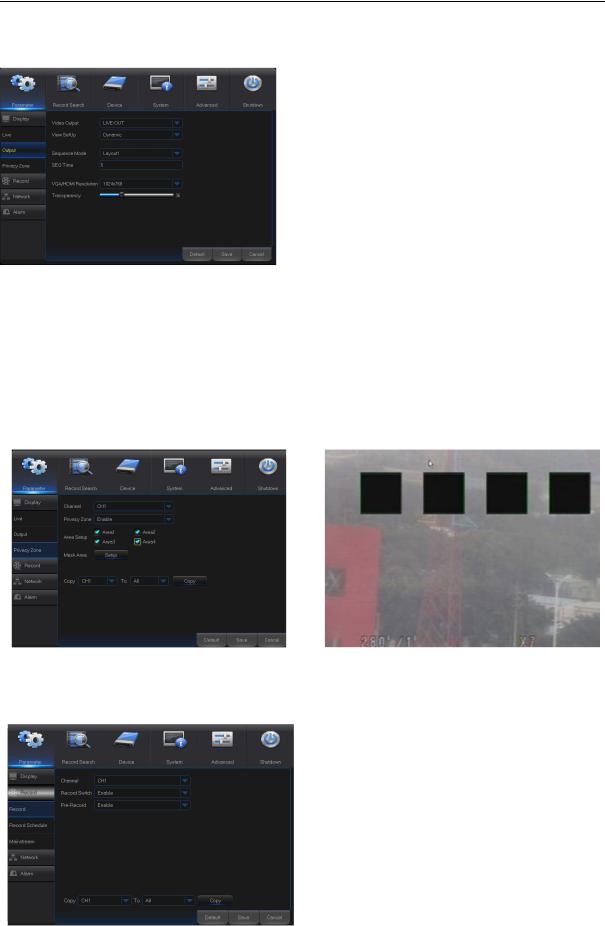
USER MANUAL
2. Output
Go to “Main Menu”→ “Parameter”→ “Display”→ “Output” to enter into the interface shown as
Picture 5-5.
Video Output: Live Output
Sequence Mode: Set sequence mode
SEQ Time: Sequence time is set 5 seconds by default. User may set it as required
VGA/HDMI Resolution: For VGA output or HDMI output, the optional resolution include 800×600, 1024×768, 1280×1024, 1440× 900, 1280×720, 1920×1080
Transparency: Adjust menu transparency in the range of 0--128.
Picture 5-5
3. Private Zone
Go to “Main Menu” → “Parameter” → “Display” → “Private Zone” to enter into the interface shown as in Picture 5-6.
Privacy Zone is for setting some invisible parts in the selected channel, as shown in Picture
5-6 and Picture 5-7.
1.Select the number of the zone to be set (maximum 4 zones can be set for single channel)
2.Click “Setup” to adjust the position of the zone.
3.After finish setting, right click the mouse to return to the “Privacy Zone” page.
4.Click “Save” to save the setting.
Picture 5-6 |
Picture 5-7 |
4. Record
Go to “Main Menu” → “Parameter” → “Record” → “Record” to enter into the interface shown as Picture 5-8.
Channel: Set the desired channel in the drop-down menu
Record Switch: Enable/disable record Pre Record: Enable to pre-record
motion detection or I/O trigger record.
Picture 5-8
10
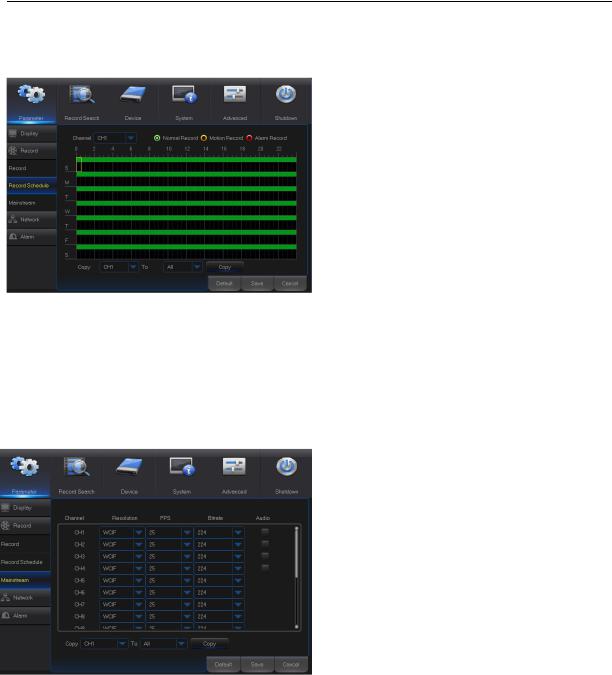
USER MANUAL
5. Record Schedule
Go to “Main Menu” → “Parameter” → “Record” → “Record Schedule” to enter into the Record Schedule interface to make record schedule for DVR, as shown in Picture 5-9.
Select the channel and the date to be set. One week’s schedule can be set.
The record schedule of the current channel can be copied to any other channel or all channels.
Note:
1. In the Record menu and Record Search menu, No Color stands for no record;
2. “Green” stands for normal record and
“yellow” stands for motion record
3. “Red” stands for alarm record,
Picture 5-9
6. Mainstream
Go to “Menu” → “Parameter” → “Record” → “Mainstream” to enter into the menu interface, as shown in Picture 5-10.
“Main Menu”→ “Record” → “Mainstream”
Mode: Support 960H and D1. Select a resolution, save and exit main menu. Then the system will automatically restart to take effect.
Resolution (960H): Support three kinds of picture quality: WD1, WHD1, WCIF.
Resolution (D1): Support three kinds of picture quality: D1, HD1, CIF.
Note: In AHD series, the supported record resolution includes 960H/720P/1080P In TVI series, the supported record resolution includes 720P/1080P.
Picture 5-10 |
|
FPS PAL: 1--25f/s; NTSC: 1--30f/s. |
||||
|
Bitrate: Bitrate for local storage. User may |
|||||
|
||||||
|
|
select in the drop down list. |
|
|||
|
Audio: Check |
the box |
to record |
channel |
||
|
|
audio during recording and there will be |
||||
|
|
audio output |
during |
playing |
record. |
|
|
|
Un-check the box to disable recording audio |
||||
and there will be no audio output during playing the record
11
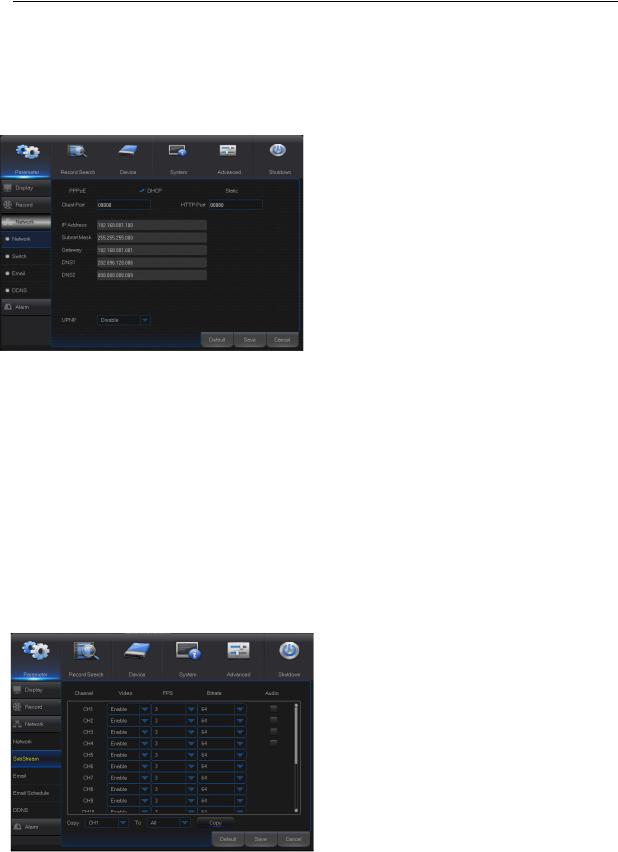
USER MANUAL
7. Network
Go to “Main Menu” → “Parameter” → “Network” → “Network” to enter the interface shown as Picture 5-11.
Select a kind of network connection (PPPOE, DHCP, Static) and set Port, and user may remotely control the monitoring, recording, playback or backup of DVR through network
Take DHCP as an example. In this mode, the router automatically assigns IP address for DVR. After restarting DVR or DHCP server, the
IP address obtained by DVR may be different. As a result, user shall check IP address and port number for each remote access of DVR. The operation procedure is as follows:
1. Select DHCP, click Save and refresh DVR. Input Client Port and HTTP Port (the two values must not be the same).
2. Set obtained IP address of DVR and the mapping port. Refer to section 4.2.4.2.
3. Remotely visit DVR by IP address:
http://Public network IP: Web port number Picture 5-11 (such as 00080)
http:// Intranet IP: Web port number (such as
00080) (Only available in the same LAN)
For PPPoe, Static and DHCP, after setting IP address of DVR, the extranet port shall be mapped on the router before visiting DVR through public network.
Note: Save after setting to make effective. If there are multiple DVRs in a LAN, make sure their MAC addresses are different (Refer to System).
8. Substream
Go to “Main Menu” → “Parameter” → “Network” → “Substream” to enter into the interface shown as Picture 5-12.
|
Video: Substream switch. Select Enable to |
|
preview the substream in the client, so as to |
|
ensure smooth playing; If Disable is |
|
selected, the client can only choose |
|
mainstream preview. |
|
FPS: FPS for network transmission. User |
|
may select value in the drop-down list. |
|
Bitrate: Bitrate for network transmission. |
|
User may select value in the drop-down list. |
|
Audio: Click √ and audio will play during |
Picture 5-12 |
network transmission. |
Synchronous transmission. |
12

USER MANUAL
9. E-mail
Go to “Main Menu” → “Parameter” → “Network” → “Email” to enter into the menu interface. Receive or Send DVR alarm Email and set parameters like Email address, SSL, Email Enable,
Interval and Email Schedule. The related parameter setting should be consistent with DVR local setting. Refer to Picture 5-13.
Picture 5-13
10. E-mail Schedule
Go to “Main Menu” → “Parameter” → “Network” → “E-mail Schedule” to make Email schedule, as shown in Picture 5-14.
Select the channel and the date to be set. One week’s schedule can be set.
The record schedule of the current channel can be copied to any other channel or all channels.
Note:
1.Green stands for Motion: Email will be sent in case of object motion;
2.Yellow stands for Alarm: Email will be sent in case of IO alarm;
3.Red stands for Exception: Email will be sent in case of exception, e.g. HDD full, HDD damage, Video loss, etc.
Picture 5-14
13
